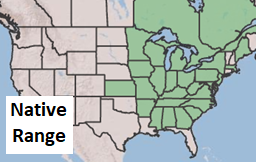Virginia Bluebells
Mertensia virginica
Click here to download a PDF of this plant information page (for printing).

Sun Exposure: Part Sun, Shade
Season of Interest: Spring
Bloom Time: March-May
Bloom Color: Pink to Blue
Height: 12 to 18 in.
Spread: 14 in.
Spacing: 16 in.
Water Needs: Average
Maintenance: Very little
Soil Type: Moist, High in organic matter
Soil pH: Acidic, Neutral, Alkaline
Soil Drainage: Well drained
Pests: Slugs (Deer and Rabbit resistant)
Diseases: None
Wildlife: Bees, Butterflies, Hummingbirds

Description:
Virginia bluebells are one of the most beautiful species of spring ephemerals. Bluebells enjoy rich, well-drained soils where they can form large colonies over time. The flowers start off pink and gradually turn over to their famous shade of light blue as they mature.
Bees, especially female Bumblebees that fly in early spring, will often be seen visiting these flowers. But the real champions of bluebell pollination are butterflies and hummingbirds.
A colony of bluebells is truly an amazing sight to behold! The blooms will last for many weeks in early spring (April and May) and will go dormant by early-summer. Virginia Bluebells prefer soils typical of a woodland - rich and a little on the damp side. For more information see:
plants.ces.ncsu.edu/plants/mertensia-virginica
Care and Growing Tips:
Virginia Bluebells perform best in partial to full shade. In nature they prefer dappled beneath deciduous trees. Native to the woodlands of Eastern North America, Virginia Bluebells benefit from regular watering. Apply mulch, preferably composted leaves to promote rich soil.
Establish strong roots with consistent yet moderate watering. Keep the soil moist (but never soggy) during the first season when the plants are getting established.
The soil should drain well and be high in organic matter. Given the right location and climate, you shouldn't have to do too much to maintain bluebells. Propagate them by seed or by division, but avoid moving these plants if you can because they develop a long taproot and don't like to be transplanted. To propagate your existing plants, only dig them up when dormant, in the fall or very early spring.
As spring ephemerals, Virginia bluebells are dormant from mid summer through mid spring the following year. There is no visible growth above ground. Since the plants will be dormant in the winter, nothing needs to be done to overwinter them. Virginia bluebells are not susceptible to pests or diseases, except for slugs. Sprinkle diatomaceous earth to stop the slugs. If the soil is not well drained, it is possible that the roots will rot. These plants are reliable bloomers so nothing extra needs to be done to get them to bloom. There is no need to deadhead.